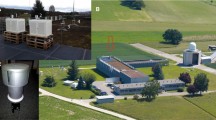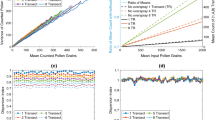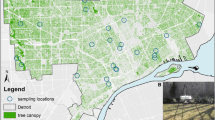Abstract
Although considered a golden standard in aerobiology, continuous long-term sampling of bioaerosols is resource demanding. The aim of this study was to explore whether, if needed, intermittent sampling could replace the continuous one without major loss of information. Hourly pollen concentrations obtained by averaging 56, 28, 14 and 7 equidistantly distributed 1.07-min concentrations of Ambrosia airborne pollen were compared. The analysis revealed that majority of information on trends and magnitude in hourly concentrations is captured even if the sampling is not continuous. The correlations were high for all intermittent sampling arrangements, but absolute percentage error increased with the decrease in samples used for calculating hourly concentration.



Similar content being viewed by others
References
Cox, C. S., & Wathes, C. M. (1995). Bioaerosols handbook (p. 656). Boca Raton: CRC Press. ISBN 9780873716154.
Crouzy, B., Stella, M., Konzelmann, T., Calpini, B., & Clot, B. (2016). All-optical automatic pollen identification: towards an operational system. Atmospheric Environment,140, 202–212.
Galán, C., Smith, M., Thibaudon, M., Frenguelli, G., Oteros, J., Gehrig, R., et al. (2014). Pollen monitoring: Minimum requirements and reproducibility of analysis. Aerobiologia,30, 385–395.
Hirst, J. M. (1952). An automatic volumetric spore trap. Annals of Applied Biology,39, 257–265.
O’Connor, D. J., Healy, D. A., Hellebust, D., Buters, J. T. M., & Sodeau, J. R. (2014). Using the WIBS-4 (waveband integrated bioaerosol sensor) technique for the on-line detection of pollen grains. Aerosol Science and Technology,48(4), 341–349.
Oteros, J., Pusch, G., Weichenmeier, I., Heimann, U., Möller, R., Röseler, S., et al. (2015). Automatic and online pollen monitoring. International Archives of Allergy and Immunology,167(3), 158–166.
Sikoparija, B., Mimić, G., Panić, M., Marko, O., Radišić, P., Pejak-Šikoparija, T., et al. (2018). High temporal resolution of airborne Ambrosia pollen measurements above the source reveals emission characteristics. Atmospheric Environment,192, 13–23.
Acknowledgements
This work was partly financed by the Swiss National Science Foundation through the SCOPES JRP No. IZ73Z0_152348 and RealForAll Project (2017HR-RS151) co-financed by the Interreg IPA Cross-border Cooperation programme Croatia—Serbia 2014–2020 and Provincial secretariat for Science, Autonomous Province Vojvodina, Republic of Serbia (Contract No. 102-401-337/2017-02-4-35-8).
Author information
Authors and Affiliations
Corresponding author
Rights and permissions
About this article
Cite this article
Sikoparija, B., Mimić, G., Matavulj, P. et al. Short communication: Do we need continuous sampling to capture variability of hourly pollen concentrations?. Aerobiologia 36, 3–7 (2020). https://doi.org/10.1007/s10453-019-09575-1
Received:
Accepted:
Published:
Issue Date:
DOI: https://doi.org/10.1007/s10453-019-09575-1




